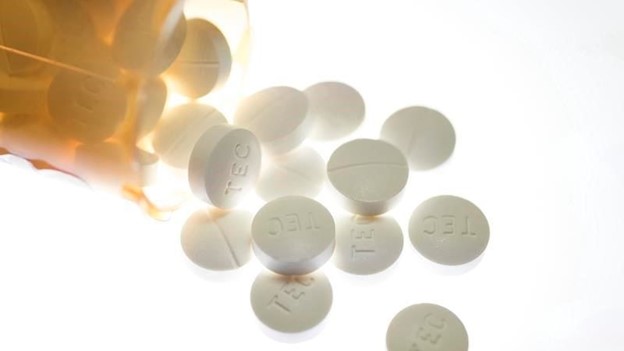Prescription pills containing oxycodone and acetaminophen are shown in Toronto, Dec. 23, 2017.
Doctors in British Columbia have a new set of clinical guidelines for treating opioid use disorder.
On Wednesday, the BC Centre on Substance Use published a new set of guidelines, replacing the previous clinical guidelines from 2017. The 2017 guidelines were published around a year after a public health emergency was declared in 2016 in response to a sharp increase in toxic drug deaths.
A lot has changed since then, including an increase in research on opioid agonist treatment, or OAT, and what does and doesn’t work for patients, said Dr. Paxton Bach, an addiction medicine physician and co-chair of the guideline writing committee.
The toxicity and unpredictability of the toxic drug supply has also increased. According to the BC Coroners Service, 1,495 people died from unregulated drugs in 2017. As of just September, 1,836 people have died so far this year.
This update will hopefully make more people interested in starting opioid agonist therapy, Bach said.
“OAT is the gold standard for the single most effective treatment for reducing non-prescribed opioid use, overdoses and mortality,” he added.
The BCCSU defines opioid agonist treatment as prescription opioids that reduce opioid-related harms, reduce how often a person uses opioids sourced illicitly, and improve their mental health, social functioning and quality of life.
In B.C., OAT includes opioids taken orally, such as Suboxone, methadone and Kadian. As of Wednesday, OAT also includes extended-release buprenorphine, which people can get as an injection at a pharmacy once every four to six weeks.
SEE ALSO:
- B.C. becomes first province to provide universal coverage for opioid treatments
- More than 190 people in B.C. per month died due to toxic drugs for 13 consecutive months: coroner
It is estimated that 100,000 people in B.C. have opioid use disorder and around one-quarter of them are already on some form of opioid agonist therapy, Bach told The Tyee.
That means there are 75,000 more people in the province who could benefit from this therapy but haven’t yet tried it or stayed on it.
Bach said one of the biggest changes is how the new guideline allows for more flexibility around missed doses and take-home doses, which he said patients had reported as the top reasons why they didn’t stay on OAT.
These are powerful opioids and if patients get sick or are away and miss several doses, there is a risk that they will have lost some drug tolerance, he said.
“We want to ensure the medication doesn’t put anyone at risk but we also know decreasing a dose unnecessarily can be destabilizing for a patient and can make people stop taking OAT entirely,” he said.
The new guidelines work to balance the risk of patient destabilization and the risk of patient safety, he added.
They also relax the rules around when a patient can take extra doses of OAT home with them.
As these medications are highly regulated, most people need to go to a pharmacy every day to get their prescription, which they consume on-site, supervised by a pharmacist, Bach said.
“This is a huge barrier for patients and an enormous cost on our system. In total, requiring [patients] to go to the pharmacy daily costs B.C. around $30 million per year,” he said.
Daily pharmacy visits are that much more taxing for people in remote or rural communities, said Jess Lamb, co-founder and project co-ordinator of the East Kootenay Network of People Who Use Drugs. If a patient lives an hour away from their pharmacy, they have to drive 14 hours in a week to get vital medication, she said — and the cost of gas isn’t cheap.
The new guidelines allow patients to access take-home doses more quickly than before, and call for a more collaborative decision-making process around what medications a patient will be on.
Previously, it was recommended that a doctor first prescribe a patient Suboxone and, if it didn’t work, that they try prescribing methadone and Kadian as a final option.
That was taxing for patients, so now they will be able to talk with their doctor about the effects of different medications and work out what would best help them right away, Bach said.
The dosing recommendations for each medication have also been increased to better match the potency of the illicit street supply, Bach said.
This is an important update, Lamb said. She personally has had to spend a lot of time advocating for the medication and dose she wanted from her OAT and safer supply to avoid getting sick. This update could help people avoid a situation like hers in the future, she said.
Sign up for the CHEK Now daily email newsletter to get breaking news and the day’s top stories sent to your email.Sign Me Up
Lamb celebrated the updated guidelines. But she added she was concerned that not all clinicians will read or respect these updates and patients will still have to fight with their primary care provider to get the medication they need through OAT.
Guy Felicella, a peer clinical adviser with the BCCSU, also applauded the updates.
“These new guidelines will make treatment more appealing,” he said.
Felicella said he tried OAT back when he used drugs. The dose then was so low that it was laughable, he said.
Empowering patients to ask for and get the medication they need at the dose they need will go a long way to helping patients want to try OAT and stay on it, he said.





